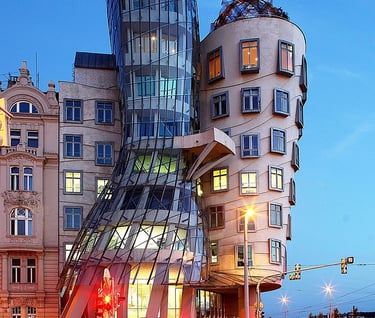Pop Art's Playful Impact on Architecture and Public Spaces
A Celebration of Influential Artists
Olivia Masters
8/1/20232 min read


The Pop Art movement of the 1950s and 1960s extended its bold and colorful influence beyond the confines of canvas and gallery walls, making a profound impact on architecture and public spaces. With its vibrant palette, playful imagery, and celebration of mass culture, Pop Art transformed buildings, installations, and urban landscapes into immersive experiences. In this article, we will explore how Pop Art's influence revitalized architecture and public spaces, celebrating the visionary artists who embraced the movement's spirit and left a lasting mark on the environment.
Frank Gehry - Sculptural Architecture with Pop Art Elements:
Frank Gehry, a pioneering architect, ingeniously incorporated Pop Art aesthetics into his buildings. Known for his sculptural and expressive designs, Gehry's use of vibrant colors and unconventional shapes breathed life into urban spaces. His Guggenheim Museum Bilbao in Spain and the Walt Disney Concert Hall in Los Angeles exemplify Pop Art's bold and dynamic influence on contemporary architecture.
Claes Oldenburg and Coosje van Bruggen - Transforming Ordinary Spaces:
Collaborative artists Claes Oldenburg and Coosje van Bruggen reimagined public spaces with their oversized sculptures, evoking the spirit of Pop Art's fascination with everyday objects. Their iconic creations, such as the "Giant Three-Way Plug" and "Spoonbridge and Cherry" installations, brought whimsy and playfulness to urban environments, transforming mundane locations into joyful spectacles.
Robert Venturi - Playful Postmodern Architecture:
Robert Venturi, an influential architect and theorist, embraced Pop Art's boldness in his designs. Considered a leading figure in the postmodern architectural movement, Venturi challenged modernist ideals by celebrating kitsch and popular culture. His design for the Vanna Venturi House and the inclusion of playful elements in his buildings demonstrate his engagement with Pop Art's aesthetic principles.
James Rizzi - Enlivening Cityscapes:
James Rizzi, a pop artist known for his colorful and whimsical illustrations, translated his distinctive style into public art installations. His intricate murals and sculptures adorned buildings and streetscapes, breathing life into the urban environment and infusing it with vibrant energy. Rizzi's playful contributions embraced Pop Art's celebration of mass culture and delighted passersby with their animated charm.
Keith Haring - Art Activism in Public Spaces:
Keith Haring, an iconic street artist, used public spaces as his canvas for both artistic expression and social activism. His graffiti-inspired murals, featuring his signature characters, adorned subway stations and city walls, advocating for social change and awareness. Haring's engagement with public spaces exemplifies Pop Art's reach beyond galleries, engaging with a broader audience and impacting the social fabric.
The Pop Art movement's exuberant impact on architecture and public spaces is a testament to its enduring creativity and cultural significance. Influential artists like Frank Gehry, Claes Oldenburg and Coosje van Bruggen, Robert Venturi, James Rizzi, and Keith Haring embraced Pop Art's vibrant and playful aesthetics, transforming urban landscapes into immersive experiences of color and joy. Their visionary creations continue to inspire architects, artists, and urban planners, reaffirming the movement's profound influence on the built environment. As we celebrate these visionary creators, we also recognize the enduring power of Pop Art to animate public spaces, foster cultural conversations, and leave a lasting imprint on the places we inhabit and explore.
